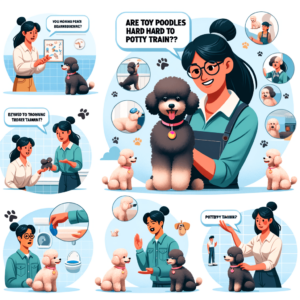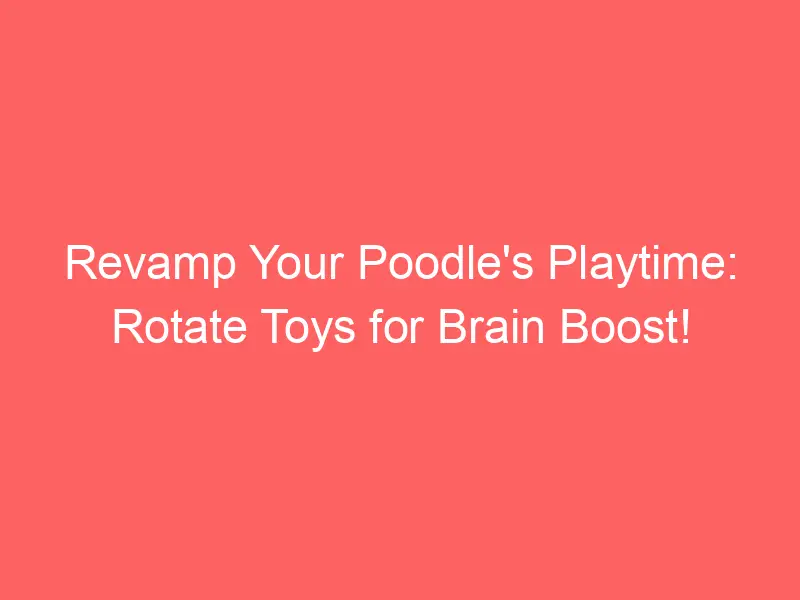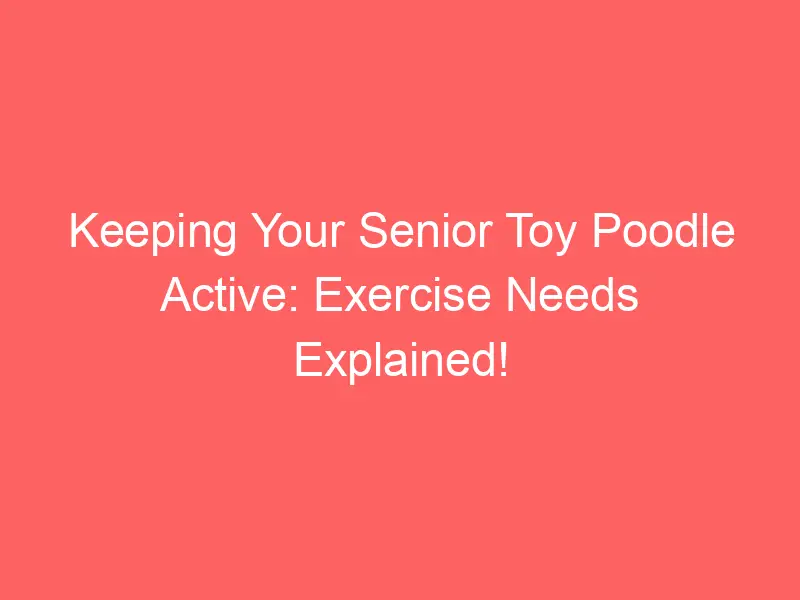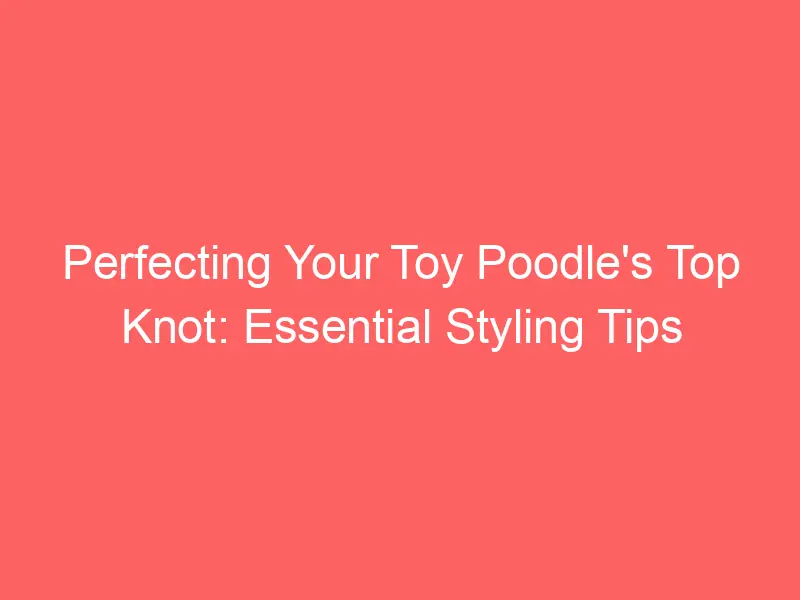Introduction to Toy Poodle Training

Training your toy poodle is an essential part of raising a well-behaved and happy pet. This article will guide you through the basics of toy poodle training, focusing on the importance of training and an overview of behavior training.
-
- Understanding the importance of training your toy poodle
Training your toy poodle is not just about teaching them tricks or obedience commands. It’s about building a strong bond with your pet and ensuring they are well-behaved and safe. Training helps to stimulate your poodle’s mind, keeping them mentally sharp and active. It also helps to prevent behavioral problems, such as excessive barking or chewing. According to a study published in Wikipedia, dogs that receive regular training are less likely to develop behavioral issues.
-
- Overview of toy poodle behavior training
Behavior training for a toy poodle involves teaching them how to behave appropriately in various situations. This includes basic commands like ‘sit’, ‘stay’, and ‘come’, as well as more complex behaviors like not jumping on people or barking at other dogs. Behavior training should start as early as possible, ideally when your poodle is still a puppy. This is because puppies are more receptive to learning and can absorb new information quickly. However, it’s never too late to start training your toy poodle. With patience and consistency, you can teach an old dog new tricks!
In the following sections, we will delve deeper into specific aspects of toy poodle training, including potty training, bite inhibition, recall training, and more. So, stay tuned and get ready to embark on a rewarding journey of training your toy poodle.
Are Toy Poodles Hard to Potty Train?
Training a toy poodle to use the bathroom outside can be a challenging task for many pet owners. However, with the right strategies and a lot of patience, it is certainly achievable. Let’s delve into the challenges and effective strategies for potty training your toy poodle.
-
- Challenges in Potty Training Toy Poodles
Toy poodles, like many small breeds, can be a bit more difficult to potty train. This is often due to their small size and fast metabolism, which can lead to more frequent bathroom needs. Additionally, toy poodles are known for their intelligence and stubbornness, which can sometimes make them resistant to training. However, it’s important to remember that every dog is unique and these challenges can be overcome with the right approach.
-
- Effective Strategies for Potty Training
Consistency is key when it comes to potty training your toy poodle. Establish a regular bathroom schedule and stick to it. This can help your poodle understand when and where they should go. Positive reinforcement, such as treats and praise, can also be very effective. Remember, patience is crucial during this process. It may take time, but with persistence, your toy poodle will eventually get the hang of it.
For more detailed information on toy poodle training, you can refer to the Wikipedia page on Poodles.
How to Train a Toy Poodle Not to Bite
Training a toy poodle not to bite is an essential part of their upbringing. Biting can be a sign of fear, aggression, or simply a way for your puppy to explore their world. However, it’s important to curb this behavior early on to prevent it from becoming a habit.
-
- Understanding why toy poodles bite
Before you can effectively train your toy poodle not to bite, it’s crucial to understand why they might be doing so. Biting is a natural behavior for puppies. They use their mouths to explore their environment and interact with their world. However, when it comes to toy poodles, biting can also be a sign of fear or anxiety. Toy poodles are known for their intelligence and sensitivity, and they may react to stressful situations by biting. Wikipedia provides more information on the characteristic traits of poodles.
-
- Steps to prevent biting behavior
There are several steps you can take to prevent biting behavior in your toy poodle:
-
- Start Early: The earlier you start training your puppy not to bite, the better. This is when they are most receptive to learning new behaviors.
- Use Positive Reinforcement: Reward your puppy when they behave correctly. This could be with a treat, praise, or a favorite toy.
- Redirect the Behavior: If your puppy starts to bite, redirect their attention to something else, like a chew toy.
- Teach Bite Inhibition: This is a technique where you teach your puppy to control the force of their bite. This can be done by yelping or saying “ouch” in a high-pitched voice when they bite too hard.
- Consult a Professional: If you’re struggling to control your puppy’s biting, don’t hesitate to seek help from a professional dog trainer.
Remember, patience and consistency are key when training your toy poodle not to bite. It may take time, but with the right approach, you can help your puppy understand that biting is not acceptable behavior.
How to Train a Poodle to Come
Training your poodle to come when called, also known as recall training, is an essential part of your dog’s education. It’s not just about convenience; it’s a matter of safety. A well-trained poodle that responds to recall can avoid dangerous situations, like running into traffic or getting lost. Let’s delve into the importance of recall training and some effective techniques you can use.
-
- Importance of recall training
Recall training is crucial for every dog, regardless of breed. It’s particularly important for poodles due to their high energy levels and curiosity. Without proper recall training, a poodle might run off to explore, potentially getting into dangerous situations. Recall training ensures that your poodle will return to you when called, keeping them safe and under control.
-
- Effective recall training techniques
There are several effective techniques for recall training. One of the most common is the ‘come’ command. Start by standing a short distance away from your poodle. Call their name, followed by the command ‘come’. When your poodle comes to you, reward them with a treat and praise. Gradually increase the distance as your poodle gets better at responding to the command. Remember, patience and consistency are key in recall training.
Another technique is the ‘restrained recall’ method. In this method, one person holds the poodle while another calls them. When the poodle responds and comes, they are rewarded with treats and praise. This method can be particularly effective as it combines the excitement of being released with the reward of coming when called.
Recall training is a vital part of your poodle’s training. It ensures their safety and gives you peace of mind. With patience, consistency, and the right techniques, your poodle will soon be responding to your call every time.
Poodle Training 101
Training a poodle can be a rewarding experience. These intelligent dogs are known for their ability to quickly pick up commands and tricks. In this section, we will focus on the basic commands every poodle should know: sit, stay, and heel.
Basic Commands
Before we delve into the specifics of each command, it’s important to note that consistency and patience are key when training your poodle. Always use the same words and gestures for each command. This will help your dog understand what you expect from them.
-
- Sit
The ‘Sit’ command is one of the first and most important commands to teach your poodle. It’s a way to get your dog’s attention and ensure they’re focused on you. To teach your poodle to sit, hold a treat above their nose and slowly move it back over their head. As their head goes up to follow the treat, their bottom should naturally go down. Once they’re sitting, say ‘Sit’, give them the treat and lots of praise.
-
- Stay
The ‘Stay’ command is crucial for your poodle’s safety. It can prevent them from running into dangerous situations. Start by asking your poodle to sit. Then, open your palm in front of you and say ‘Stay’. Take a few steps back. If your poodle stays, give them a treat and praise. If they don’t, go back to them, ask them to sit again, and repeat the process. Gradually increase the distance between you and your poodle.
-
- Heel
The ‘Heel’ command is used to keep your poodle walking close to you on a leash without pulling. Start the training in a quiet area. Have your poodle sit next to your left leg, with their shoulder in line with your leg. Then, say ‘Heel’ and start walking. If your poodle stays by your side, reward them with a treat and praise. If they pull or lag behind, stop walking and guide them back to the correct position before continuing.
Remember, training should be a fun and positive experience for both you and your poodle. Keep sessions short and always end on a positive note. With patience and consistency, your poodle will soon master these basic commands.
Advanced Training
After mastering the basic commands, it’s time to move on to more advanced training techniques. These techniques will help your Toy Poodle become more disciplined and agile. Let’s explore two of these techniques: leash training and agility training.
-
- Leash Training
Leash training is an essential part of your Toy Poodle’s training. It helps to ensure that your dog is safe and well-behaved when out in public. Leash training involves teaching your dog to walk by your side without pulling on the leash. This can be achieved by using a combination of positive reinforcement and gentle correction.
Start by choosing a comfortable leash and collar for your Toy Poodle. Then, take your dog for short walks, rewarding them for staying by your side and gently correcting them when they pull on the leash. Remember, patience is key in leash training. It may take some time, but with consistent effort, your Toy Poodle will learn to walk nicely on a leash.
-
- Agility Training
Agility training is a fun and engaging way to train your Toy Poodle. It involves teaching your dog to navigate through a course of obstacles, such as tunnels, jumps, and weave poles. This type of training not only provides physical exercise but also mental stimulation for your dog.
Start with simple obstacles and gradually introduce more complex ones as your dog becomes more confident. Always reward your dog for successfully completing an obstacle to encourage them to continue trying. Agility training can be a great bonding experience for you and your Toy Poodle, and it can also help to improve their obedience and focus.
In conclusion, advanced training techniques like leash training and agility training can significantly enhance your Toy Poodle’s discipline and agility. Remember, training should always be a positive and enjoyable experience for your dog. So, always use positive reinforcement and be patient with your Toy Poodle as they learn these new skills.
Toy Poodle Training Tricks
Training your toy poodle can be a fun and rewarding experience. These intelligent and playful dogs are eager to learn, and with the right training techniques, you can teach them a variety of tricks. Here are a couple of tricks you can start with:
-
Teaching Your Toy Poodle to Fetch
Fetch is a classic game that dogs love, and it’s also a great way to exercise your toy poodle. Here’s how you can teach them:
- Start by playing with a toy that your poodle loves. Toss it a short distance away and say “fetch”.
- When your poodle goes to get the toy, praise them enthusiastically.
- Once they have the toy, call them back to you. If they come back with the toy, give them lots of praise and a treat.
- Repeat this process, gradually increasing the distance you throw the toy.
Remember, patience and consistency are key when training your toy poodle to fetch.
-
Training Your Toy Poodle to Play Dead
Playing dead is a fun trick that can impress your friends and family. Here’s how to teach it to your toy poodle:
- Start by getting your poodle’s attention with a treat.
- Give the command “play dead” and gently help your poodle to lie down on their side.
- Once they’re in the ‘dead’ position, give them the treat and lots of praise.
- Repeat this process until your poodle can play dead on command.
Remember, always use positive reinforcement when training your toy poodle. This will make the training process more enjoyable for both of you.
Training your toy poodle can be a fun and rewarding experience. With patience, consistency, and positive reinforcement, you can teach your poodle a variety of tricks. Happy training!
Understanding Toy Poodle Development Stages
Just like humans, Toy Poodles go through several developmental stages as they grow. Each stage is unique and comes with its own set of characteristics and behaviors. Understanding these stages can help you train your Toy Poodle effectively and ensure their overall well-being.
-
- Puppy Stage
The puppy stage is the first stage of a Toy Poodle’s life, typically lasting until they are about six months old. During this time, puppies are very curious and eager to explore their surroundings. They are also highly impressionable, which makes it an excellent time to start basic obedience training. However, they have short attention spans, so training sessions should be short and fun. Puppies also need plenty of sleep to support their rapid growth and development.
-
- Adolescent Stage
The adolescent stage typically begins around six months and lasts until the Toy Poodle is about a year old. This stage is often characterized by a surge in energy and a desire for independence. Adolescent Toy Poodles may start to test boundaries, so consistent, positive reinforcement training is crucial during this time. Socialization should also continue to ensure they are comfortable around different people, animals, and environments.
-
- Adult Stage
The adult stage begins around one year of age and lasts for the rest of the Toy Poodle’s life. Adult Toy Poodles are usually calmer and less energetic than their younger counterparts. They are capable of more complex training and can focus for longer periods. However, they still require regular mental and physical stimulation to keep them happy and healthy. Regular vet check-ups are also essential during this stage to monitor their health.
Understanding these stages of development can greatly assist in training your Toy Poodle and meeting their needs at each stage. Remember, every dog is unique, and the exact timing and characteristics of these stages may vary.
Poodle Training Tips
Training your poodle can be a rewarding experience for both you and your furry friend. Here are some essential tips to help you navigate this process effectively:
- Consistency is key: Poodles are intelligent dogs that thrive on consistency. When training your poodle, it’s important to be consistent in your commands and actions. This means using the same words and gestures each time you give a command. For example, if you use the word “sit” to instruct your poodle to sit, stick to this word and avoid using other terms like “down” or “stay”. This consistency helps your poodle understand what you expect from them, making training more effective.
- Positive reinforcement: Positive reinforcement is a proven method for training dogs. This involves rewarding your poodle when they perform a desired behavior, such as sitting or staying on command. Rewards can be treats, toys, or simply praise and affection. According to a study on dog training methods, dogs trained using positive reinforcement are more likely to obey commands and less likely to exhibit problem behaviors.
- Patience and understanding: Training a poodle, or any dog for that matter, requires a lot of patience. It’s important to understand that your poodle may not get things right the first time, or even the tenth time. They may have days where they seem to forget everything they’ve learned. This is normal. Remember, training is a process, not an event. Be patient, keep your training sessions short and fun, and always end on a positive note.
By following these tips, you can make the training process a positive and enjoyable experience for both you and your poodle.
Conclusion: Mastering Toy Poodle Training
As we wrap up our comprehensive guide on toy poodle training, it’s essential to remember that patience, consistency, and positive reinforcement are the keys to success. Let’s recap some of the key takeaways and discuss the importance of continued learning and development.
-
- Recap of Key Takeaways
Toy Poodles are intelligent and eager to please, making them relatively easy to train compared to other breeds. However, they can be stubborn at times, so it’s crucial to be patient and consistent. Potty training may be a challenge, but with regular routines and rewards, your toy poodle will soon get the hang of it. Training them not to bite involves redirecting their biting behavior towards toys or chewable items. Teaching them to come when called is a vital safety measure and can be achieved through positive reinforcement techniques. Understanding their development stages helps in tailoring appropriate training methods and expectations. Lastly, remember that every dog is unique, so what works for one might not work for another.
-
- Continued Learning and Development
Training your toy poodle doesn’t end with mastering the basics. It’s a continuous process that requires ongoing effort and commitment. As your toy poodle grows and develops, their training needs will change. It’s essential to stay updated with the latest training techniques and methods to ensure that your toy poodle remains well-behaved and happy. Regular training sessions not only keep your dog mentally stimulated but also strengthen your bond with them. Remember, a well-trained dog is a happy and confident dog.
In conclusion, training a toy poodle can be a rewarding experience. With the right approach and a lot of love, your toy poodle will become a well-behaved and cherished member of your family. Happy training!














